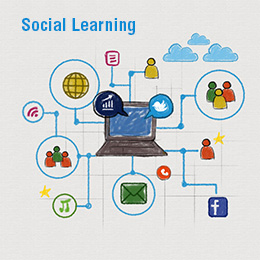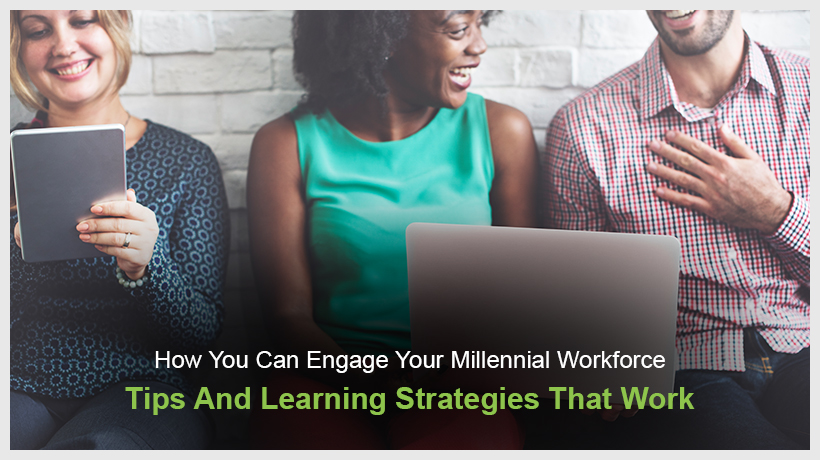
Social learning is the acquisition of knowledge and behaviors through interactions. This article explores benefits, strategies, and skill-based practices that organizations can leverage to foster learning continuity and stay future-ready.
What Is Social Learning?
In simple terms, social learning is learning with and from others. You do that pretty much every day in some way or the other – when discussing a problem or challenge to a colleague or a friend, as part of a group discussion, when interacting with others in a conference, or when using online social media channels like Facebook, Twitter, LinkedIn, and so on.
Historical Background
The early theoretical foundations of social-cognitive learning theories paved the way for important advances in understanding human development and behavior. In the 1920s, Lev Vygotsky’s theory of social cognitive learning began as a revolutionary perspective that challenged traditional views of the role of culture, language, and social context in shaping individual learning and development. The theory emphasized the inseparable link between social interaction and cognitive processes.
Based on the work of Vygotsky, the 1960s gave rise to Albert Bandura’s social learning theory, which extends the framework of social cognition proposed by Bandura as developing not only through direct experience but through observing and imitating others in social situations. He introduced the concept of modeling, where individuals learn by observing the actions and outcomes of others and emphasized the importance of cognitive processes such as attention, retention, reproduction, and motivation in this learning process.
Over time, these theories have evolved and been refined, incorporating insights from a variety of disciplines, including psychology, sociology, and education. Technological developments such as the integration of digital media and virtual environments have influenced the application and understanding of social-cognitive learning theories in contemporary contexts. Despite these developments, the basic principles of these theories remain relevant and provide valuable insights into how social interactions, cultural factors, and cognitive processes shape learning and behavior.
Albert Bandura’s Social Learning Theory
Albert Bandura’s social learning theory revolutionized our understanding of human behavior by emphasizing the importance of social modeling and observational learning. Bandura’s concept is that individuals learn not only via direct experience but by way of observing others in their social environment. Here’s an outline of Bandura’s 4 principles of effective social learning:
- Attention: Bandura emphasized that individuals could learn from a role model if they pay attention to the role model’s actions and consequences. Factors such as the type of sample and the complexity of the behavior influence attention.
- Retention: Recall of observed behaviors is important for later reproduction. Bandura suggested strategies such as rehearsal and organization to increase retention, but difficulties such as memory loss can prevent it.
- Reproduction: Once a behavior is identified and retained, the individual must be able to reproduce it. Bandura emphasized cognitive processes such as mental rehearsal to translate observed behavior into action.
- Motivation: Bandura noted that individuals are more likely to imitate behaviors if motivated to do so. Motivation is influenced by factors such as rewards and punishments, self-efficacy beliefs, and social context.
What Are the Benefits of Social Learning?
Integrating social learning in your learning strategy has benefits for both learners as well as the business. Social learning can enhance the learning experience and result in a positive outcome both in terms of the success of your learning initiative and a positive ROI.
Let’s see the value it offers to the learners and to business.
The Learner Perspective
How learning happens: As per the 70/20/10 model for Learning and Development, learners obtain:
- 70% of their learning from on-the job experiences.
- 20% of their knowledge from interactions with others.
- 10% of the learning from structured or formal training.
It is here that social learning comes in as a key enabling factor for learning as it triggers learning through collaboration with peers on the job and interactions with others.
Specifically:
Social learning empowers learners: Sometimes all it takes is one little tip or a piece of advice from a fellow colleague to help you re-focus on your work or get the job done faster in the workplace. Collaboration and interaction help learners learn better. This way, social learning not just helps learners retain the learning but also helps apply that learning on the job.
Appeals to Millennials: Millennials are poised to take over as the majority of the global workforce in a few years and they are the future of organizations. This generation loves social media and social learning. They use social media more (59%) than others (29%) and are likely to relate to social learning more than people from other generations.
The Business Perspective
There are advantages for businesses as well, as social learning:
- Facilitates learner engagement.
- Brings about self-organization among learners.
- Triggers collaboration.
- Can be used to supplement all kinds of training needs and enhance the impact of new initiatives such as Change Management.
Challenges and Limitations of Social Learning
The challenges and limitations of social learning include a variety of factors:
- Dealing with misinformation and information overload: Social learning should address both misinformation and information overload, ensuring that learners get accurate information from multiple sources.
- Evaluating Measurability in Social Learning Outcomes: Measuring social learning outcomes is challenging due to complex interactions, which require robust evaluation methods.
- Potential risks of negative role modeling: In social learning, negative role modeling can lead to the adoption of undesirable behaviors, which requires encouraging positive role modeling and guidance on discernment.
- Balancing individual learning styles with group development: Effective social learning requires balancing individual learning styles with group development, promoting an inclusive environment and encouraging collaboration.
- Overcoming bias and dealing with conflicting views: Social learning encompasses a variety of perspectives, exploring strategies for overcoming bias and managing conflict constructively.
- Navigating Discussion Pitfalls in Learning Management Systems (LMS): LMS discussions require guidelines to avoid off-topic discussions and provide an appropriate learning environment to ensure engagement.
Social Learning in Corporate Training
Social learning in corporate training uses the power of social behavior and learning theory to promote professional development in organizations. Creating employee learning communities allows employees to observe and emulate fellow members, leading to significantly improved learning outcomes compared to traditional methods These communities encourage a culture of shared knowledge and support company-wide learning and development initiatives. In today’s hybrid work environment, where remote and on-premises employees coexist, corporate learning communities play an important role in preventing fragmentation and facilitating collaborative learning.
Effective lifelong learning in professional development depends on its ability to empower learners and provide opportunities for continuous skill development. By creating corporate learning communities, organizations can implement learning at scale, allowing employees to manage their own learning journeys. This shift from a top-down approach to a member-driven model improves collaboration, better coaching and feedback, and ultimately fosters individual and collective growth. Social learning, according to the 70/20/10 model, emphasizes learning from others as a primary means of skill acquisition, making it an invaluable tool for learners and employers alike in today’s remote work environment.
What is the Relationship Between Social Media and Social Learning?
Social media provides basic technology to connect people. All of us use it to keep in touch with our friends or for networking with business contacts and often to share our thoughts and opinions. But its capability does not end here. It can also be leveraged as an effective tool for collaborative or social learning. The key being, how we use this meaningfully to encourage exchange of ideas and knowledge sharing.
What Social Learning Strategies Can Help You Build a Corporate Learning Community?
A good social learning program brings together a diverse array of social media elements, including hosted discussion groups, blogs, podcasts, video links, wikis, etc., and combines them with the following strategies:
- Forums: Decide how to group the community – work teams/by topic/by department – to best manage member queries and deliver support.
- Interaction: Encourage interactions and engagement by promoting discussions, sharing, opinions, and contributions among community members.
- Promotion: Market your community and connect learners. Actively encourage employees to join your corporate learning community.
- Curation: Carefully curate your learning resources, including Microlearning and mLearning content, to whet everyone’s appetite.
- Gamify: Inject fun, encourage competition within the community, and target specific learning outcomes through gamification. Badges, points, competitions, and leaderboards add to the thrill.
- Leverage user-generated content (UGC):UGCs are the hallmark of social learning, through which community members help other members learn.
Are There Any Best Practices that Can Help?
Yes. Some of these best practices can make your online Learning design initiative a success are as follows:
Facilitating a social learning platform where learners are spaced apart; this will help:
- In distributed problem solving whereby small problems could be nipped in the bud without being allowed to cause bigger challenges later on
- Nurture a creativity-fostering environment
- Form temporary workgroups to tackle business challenges
- Create a flexible work environment
Encouraging learners to build collaborative knowledge base of their own rather than depending on others’ assistance.
Bridging the distance gap between learners and fostering team spirit through:
- Increased participation
- Projecting them as representatives of the corporate brand
- Developing a community
Providing them adequate motivation and learner engagement as it is a prerequisite for any learning to take place.
Here are two case studies that demonstrate how social learning strategies could help achieve the intended outcomes.
Case Study 1: Equipping Learners for a Business Challenge Through a Collaborative Simulation
Background
A large Indian conglomerate wanted to train its communication teams to effectively handle crises such as journalists spreading misinformation, social activists highlighting public concerns, employees sharing their opinions on social media, and so on. The traditional instruction-based workshop format wasn’t ideal for equipping the employees to respond to situations correctly.
Solution
A ‘Day in the Life Of’ simulation delivered through a virtual workshop. This simulation placed learners in the role of PR representatives for a fictional company facing a public relations nightmare after a virtual earthquake damaged their nuclear reactor. Learners had to discuss with Group Heads and choose the right decision for each situation. They could see the consequences of their decisions and experiment with different approaches.
The Impact
Learners reported a 98% satisfaction rate and appreciated the chance to practice crisis communication in a safe, collaborative environment. The simulation helped the teams develop the skills they need to respond quickly and accurately to crises, mitigate negative publicity, and maintain the organization’s reputation.
Case Study 2: Educating Employees Through Social Learning Features
Background
A leading insurance company was looking to spread awareness among its employees about various health issues and the benefits of walking in a fun and effective manner.
Solution
An interactive virtual walkathon portal that allowed learners to record their daily steps with Fitbit devices. Comprehensive individual level and group level leaderboards were displayed to drive motivation. Moreover, learners could participate in offline team building activities related to fitness throughout the training, which were tracked through the platform.
The Impact
The organization reported high engagement with the platform through the recorded progress and improvement in daily step count.
The Future of Social Learning
As remote and hybrid work models become the norm, social learning plays a greater role than before in shaping the future of work. However, while the potential of social learning is clear, studies show that there are differences in how well it will be used. In this context, the role of artificial intelligence (AI) stands out as a promising strategy for improving social learning processes. By personalizing learning experiences and applying data-driven insights, AI can bridge the gap by optimizing learning outcomes and providing effective learning opportunities in the workplace.







